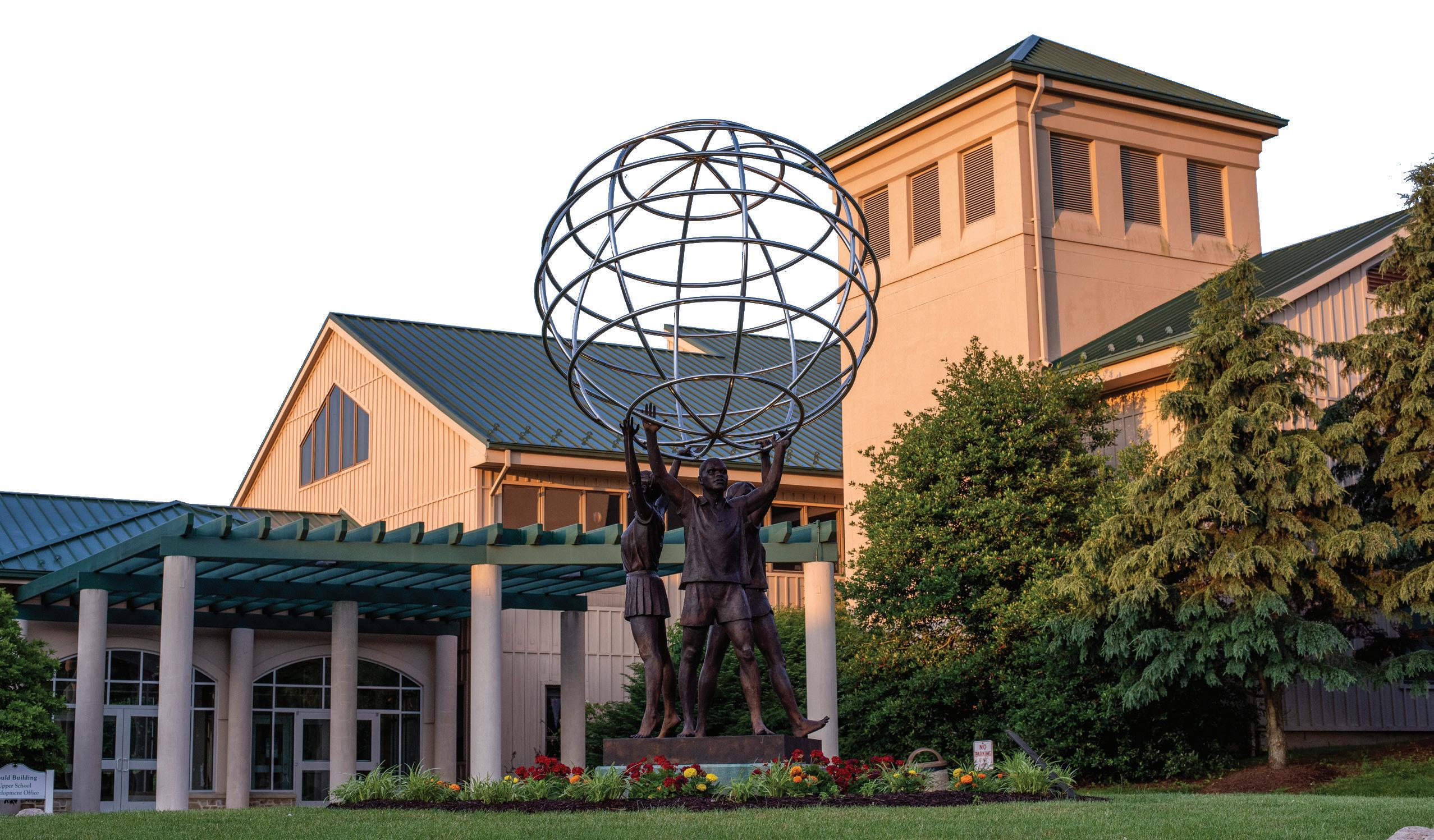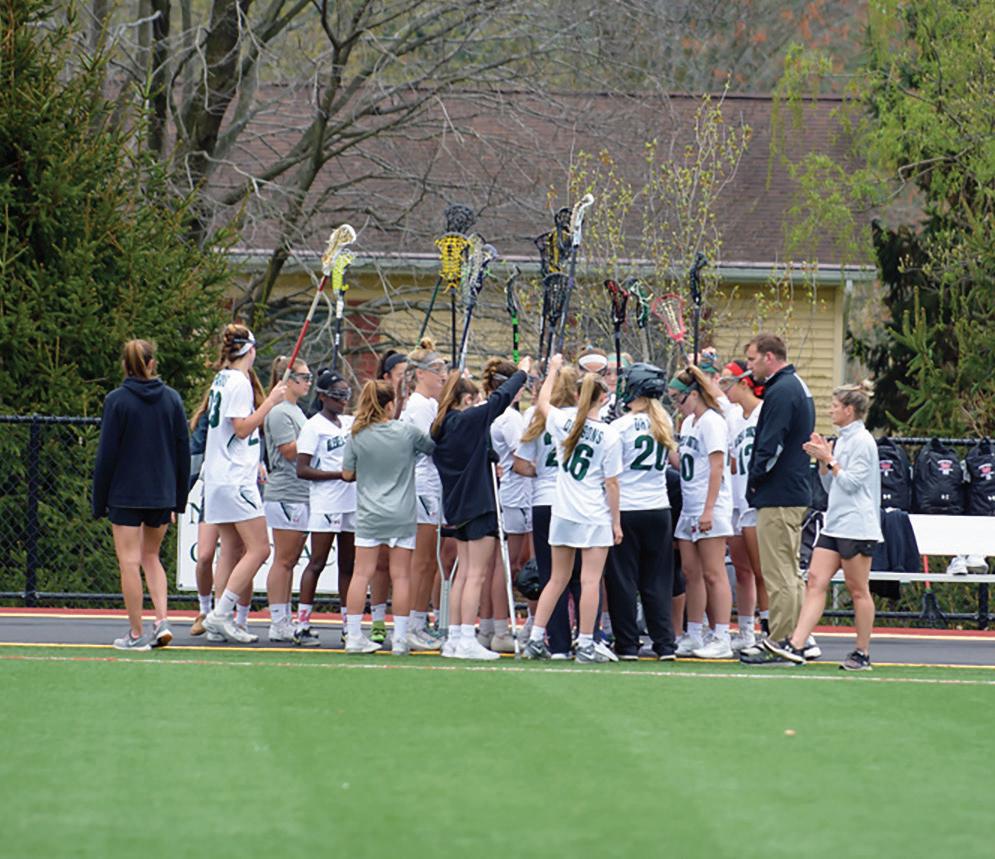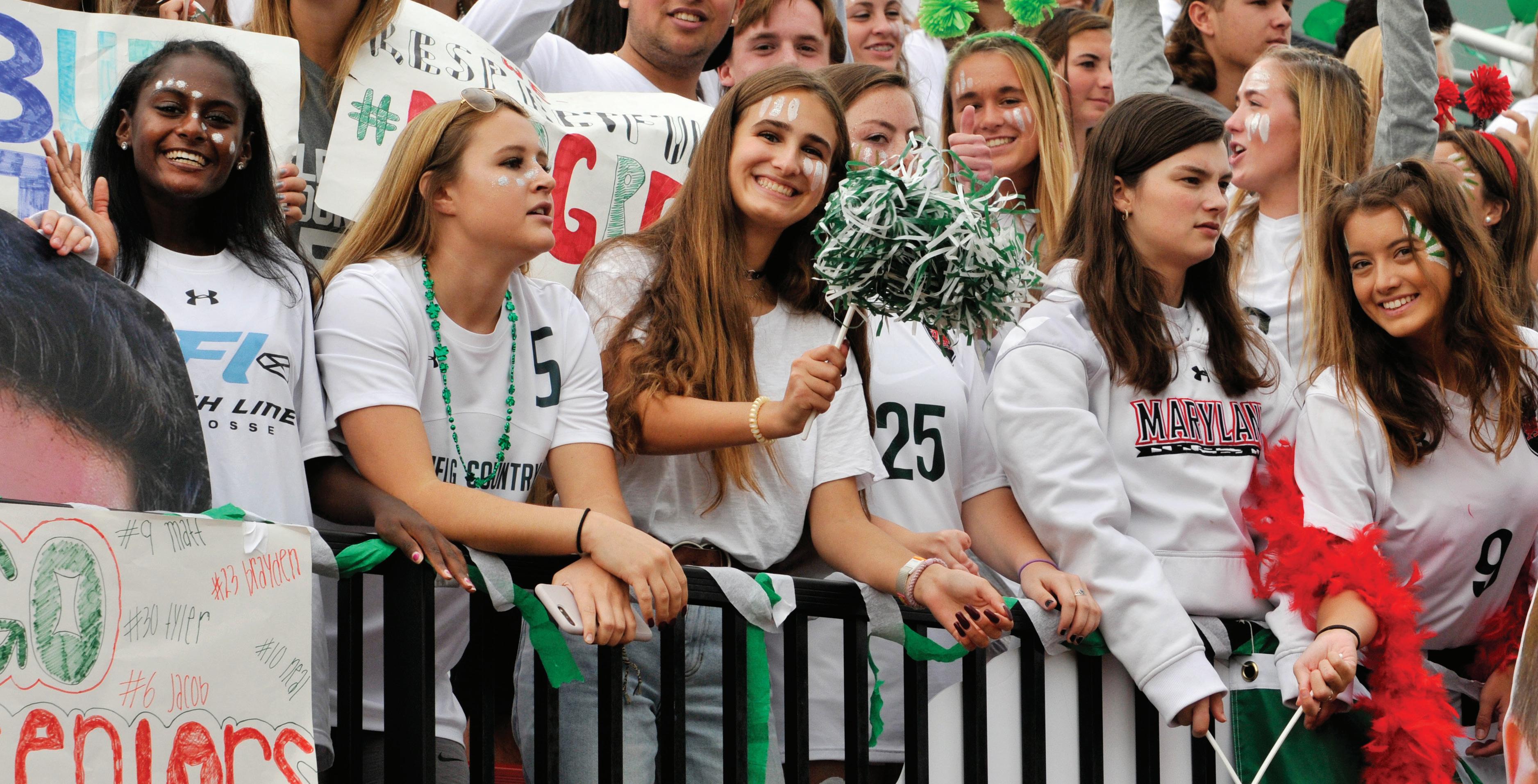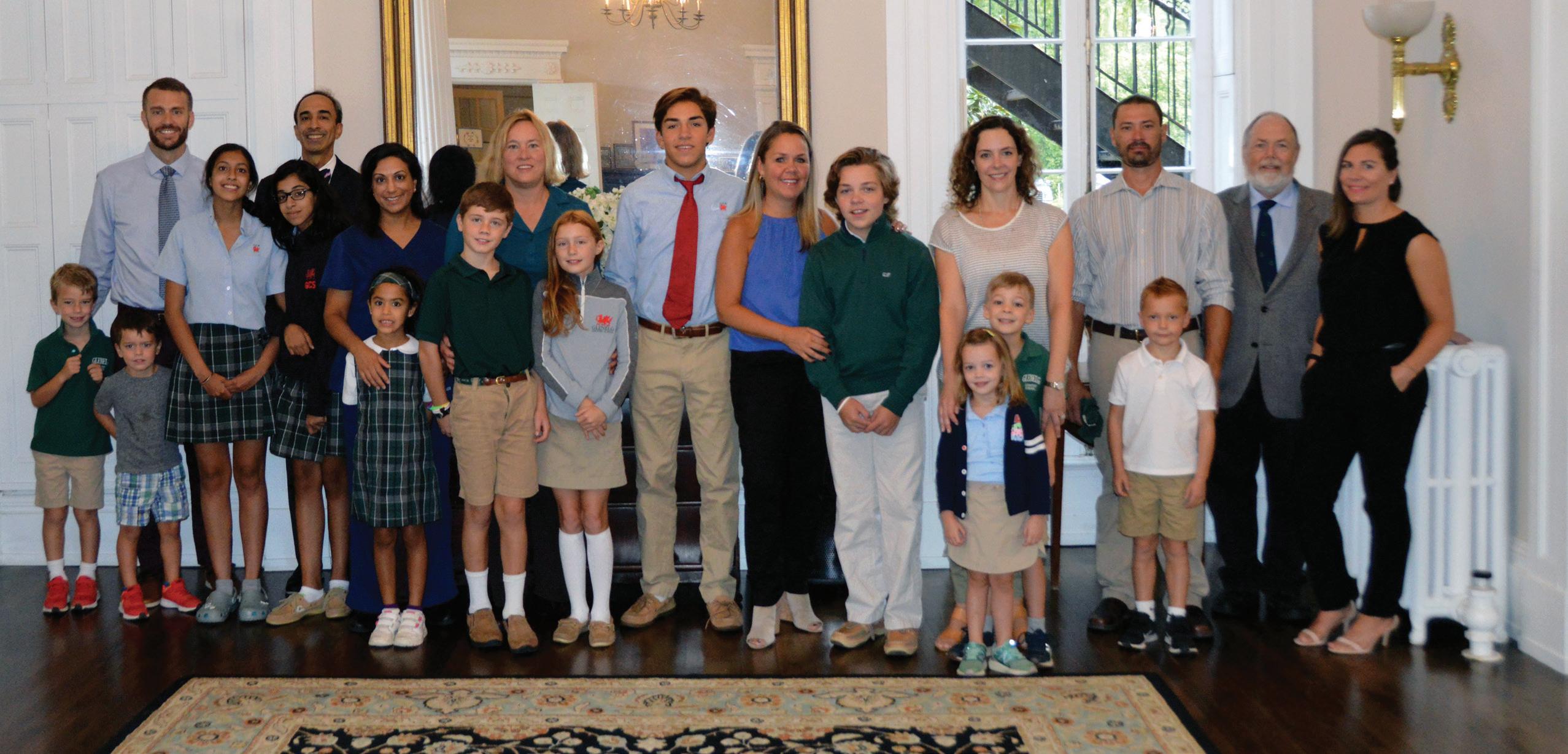
15 minute read
UPPER SCHOOL
Student Health and Wellness in the Upper School
By Brandon Neblett HEAD OF UPPER SCHOOL
One of the things that most impressed me as I was getting to know Glenelg Country School (GCS) last year was its sense of balance. In my interviews and discussions, students, teachers, and administrators all accentuated the same point to me: GCS is a lively, balanced place where people thrive. It came through in their voices, their eyes, their smiles, and their laughter. And it came through in what I witnessed as I walked around the school. I knew this was where I wanted to be and where I wanted my three children to be.
Once on the job as Upper School Head, my own experience verified these sentiments every day. I love coming to work at a school so committed to bringing out the best in students—not just in academic work, athletic achievement, or artistic performance, but in communication, relationshipbuilding, and risk-taking. I love working at a place that understands the importance of building young men and women who know themselves, celebrate each other, and try new things. I love GCS’s holistic philosophy of education and the community that fosters it.
At the same time, GCS teens face the same social and emotional challenges that teens around the country face. One of my top goals as an educator is to help teens learn how to navigate those challenges successfully.
The dramatic increase in teen anxiety is a particular concern of mine. As articles in national publications such as Time, The Atlantic, and The New York Times have documented over the past five years, while having access to unparalleled opportunities and resources compared to earlier generations, today’s teens also face unprecedented pressures.
What are these pressures? The first is academic. While a school like ours has always provided a demanding curriculum, college-bound teens face a level of competition in gaining admission to higher education that is unprecedented. At the nation’s finest universities, that competition for spaces and scholarships is now global; American students are competing with students from around the world. Second, are athletic pressures. The increase in specialization, club teams, personal training, and off-season practice and competition in high school sports are seen as essential for those who wish to play in college. This has created a cycle of year-round stress. The third set of pressures is digital. Mobile devices have completely changed the dynamics of teen social life. One manifestation of this is the use of social media sites like Instagram to post text, photos, and videos to create an idealized virtual identity, as well as to intimidate, harass, and bully other teens.
What are we doing about this issue in the Upper School? One long-standing tradition—Forum—was my starting point this fall. Forum has proved to be fertile ground for promoting weekly fun, light-heartedness, and a sense of release from the pressures of Upper School life. The first half of the year has seen community singalongs to Journey’s “Don’t Stop Believing” and “Happy Birthday” (for Dean of Students MaryEllen Prantl), a Halloween production of “The Monster Mash,” school spirit competitions led by the School Council, corny jokes and puns, and the continuation of Mrs. Vavalle’s “Fun Fridays” from last year. My many appearances at Forum, in various guises and complemented by different forms of dancing,
are driven by my desire to see students not only laugh and relax, but to also see that Forum is understood to be a safe place to share, perform, and make announcements.
In addition to enhancing this tradition, we have taken several steps in new directions to promote student health and wellness in the Upper School. For the first time in many years, students completed their exams in classrooms, returning to the Upper School academic building from the Upper School gym. Classrooms are a much more organic and authentic space for students to take their exams, and we want to support their success on these as much as we can. We know that context, and especially space, has a significant impact on how students perform. So this shift, while small, may have an outsized effect, not just in grades but in test-taking skills, confidence, and metacognition.
We are also developing a new sleep education initiative. Under Physical Education teacher and Admissions Assistant Brian Reese’s leadership, we invited local sleep expert Tracy Davenport to campus in mid-December to discuss why sleep is so important to teens’ cognitive and physical development. At Forum and in the ninth grade Ancient Studies classes, Dr. Davenport explored the neuroscience behind rest, its central role in solidifying learning and building muscle tissue, and its connection to Alzheimer’s. She also explored the factors that teens identify as most problematic to getting a good night’s sleep. We know, both from discussions with individual students and from a sleep survey we conducted in the Upper School, that teens are sleep-deprived, and we are looking at dates in the second half of the year for Dr. Davenport to return for a series of follow-up talks. Finally, we initiated a division-wide conversation about teen anxiety with our screening of “Angst”, the acclaimed new documentary about teen anxiety, on January 14. Upper School students viewed the film and participated in a series of structured conversations as a first step in acknowledging this issue and its role in our lives. We also screened the movie for parents and the public that evening as part of our Dragon Dialogue, a series of community education events. We hope this will empower both those students struggling with anxiety and their friends, siblings, and parents to act and access resources with greater confidence and hope.

As with everything we do, a strong partnership with parents is fundamental to our success. My aspiration is building a dynamic, ever-evolving conversation throughout our community about how we can recognize, address, and treat those issues we see degrading a healthy and developmentally appropriate educational experience for our students. Parents are critical partners in this conversation. There will be more to come in the Upper School. And, we hope, more to come to Upper School households. Stay tuned!
Facing page: Anusha Thompson ’20, Neal Fyock ’20, Aniya Diggs ’20, Sarah Lienert ’20, Ian Swartz ’20, Tiffany Wu ’20 Right: Aniya Diggs
FACULTY SPOTLIGHT Sheena Jordan
Sheena Jordan joined the Glenelg Country School faculty in 2019 as diversity coordinator, a new position created to bring light to our diverse community. Born in Hawaii and having moved to the continental United States, Jordan developed a passion and appreciation for other cultures.
TELL US A LITTLE BIT ABOUT YOURSELF AND YOUR EXPERIENCE.
I earned a Bachelor of Arts degree from James Madison University in Spanish, and I minored in African American studies. I received a Master of Arts at the University of Maryland, Baltimore County, in intercultural communication. In 2019, I completed my post-baccalaureate certification in educational leadership and school administration at McDaniel College in Westminster, MD. My position as a diversity coordinator allows me to facilitate discussions and foster a welcoming environment where I encourage the community to ask the questions and listen to the many voices. We are so fortunate to have in a diverse institution.
WHAT BROUGHT YOU TO GCS?
I found GCS as my home when I began looking to make a move from working solely in the classroom to administration. After completing my coursework in educational leadership, I recognized that I wanted to move into administration. However, I also knew that in my heart, I still loved the rapport and relationship-building that happens from interacting with children directly in the classroom. Having worked at a boarding school and a country day school in New York, I understand that in an independent school, you really can have the best of both worlds in teaching and administration. I love the sense of community that permeates from within class and beyond. After my first visit, I knew GCS was the place not just for me but for my family as well. We all feel so welcome here. DESCRIBE YOUR TYPICAL SCHOOL DAY.
I usually start my day in the Upper School building preparing for my sophomore foundations class. On Tuesdays and Thursdays, I have the pleasure of cosponsoring the Common Ground club and the Amnesty International club. Both organizations have dynamic representation from the student body and include all grades. We plan activities about diversity, and we also bring awareness to human rights violations happening all over the world. It is within these organizations that I teach our scholars to speak up and bring light to pressing issues by sharing out during our Upper School Forum. Fridays, I like to be able to venture down to the Manor House and participate in the Lower School assemblies. I have been delighted to present about Hispanic Heritage, Native American Heritage, and Black History Months. I enjoy the energy and optimism of the Lower School, as they are always eager and excited to explore and learn new things about other cultures.
WHAT ARE YOUR GOALS WITH STUDENTS, AND HOW DO YOU SEE YOUR DEPARTMENT DEVELOPING THROUGH YOUR WORK AND TEACHING?
My goal is to provide a system of support for the students, faculty, and the community. We are so fortunate to have such diversity represented in our students, and I want to make sure that every voice is heard and welcomed. I value voice. I have always said that there is only one difference in vice and voice. That “o” makes all the difference. I want to teach our future leaders to tap into the energy of the “o” and open their mouths and speak up when they feel misrepresented or if they feel things are unjust. I want to teach our kids to find their voice and to exercise their democratic right to speak up! My course, Foundations 10, teaches public speaking, and I hope that students will appreciate and understand that young people today have the power to change the future.
I also want adults in the community to know that I am here to offer support when challenging situations arise. I encourage courageous conversations and invite everyone to use their voice to help us grow and learn as a community. I value course correction. I know that we can’t reach our fullest potential as an inclusive community if we move through these spaces without acknowledging that there is always room for growth in our own development, even as adults.
Mrs. Jordan and Alex Cheng ’23

We Are All Dragons HOW DID THAT COME ABOUT?
By David Weeks DIRECTOR OF GLOBAL EDUCATION AND COMMUNITY SERVICE
Head of School Greg Ventre often reminds us of our commonality, even with our competitive spirit. How did we all become Dragons, and why was the dragon chosen for our identity as a school? The answers to these questions go back approximately 30 years when Rye Chapman became head of Glenelg Country School (GCS) in 1990.
At that time, our school had nine students in its first ninthgrade class located in a trailer behind the Manor House. In that class was Ty Saini, who eventually served as Chairman of the GCS Board of Trustees. The administration was changing from Charles Miller as the Kindergarten-Grade 8 Head of School to Mr. Chapman, who would lead GCS into a new era as a Kindergarten–Grade 12 school. With him was Tim Callard, hired as the new head of the Upper School. From that modest beginning, GCS has grown to have 312 students in the Upper School with 84 students in the Class of 2019.

As Head of School, Chapman launched many new traditions such as a cap and gown ceremony for the twelfth-grade graduation and creating a mascot that could motivate our school community. He approached the Upper School faculty with the challenge of choosing a mascot for our school. Being on the faculty at that time, I remember discussing the dragon as an option. The dragon was a little controversial. On one hand, it represented evil in the Western tradition, as depicted in the St. George slaying the dragon legend. But it also represented great strength and wisdom from the Chinese culture. The emperors of China sat on the “Dragon Throne” and received the knowledge of the mythical dragon that was said to have the power to travel into heaven to obtain wisdom. The dragon would bring with it Qi or life force energy to the emperor so that he could make the right decisions for his people and remain on the throne having the Mandate of Heaven. The Eastern tradition of the dragon being symbolic of strength and wisdom prevailed. A statue of a dragon was sculpted by Charles Lancaster, a member of the Gould family, cast in bronze and placed in the foyer near the Head of School’s office. Looking closely at the statue, one can see that a finger in the left talon extends upward. I like to think of this gesture as similar to that of Plato in Master Painter Raphael’s fresco of the School of Athens in the Vatican Palace in Rome completed during the Italian Renaissance. Plato’s finger-pointing upward alludes to the spiritual realm of ideas as a basis upon which to live one’s life philosophically. Next to him, Aristotle points downward, a gesture to the importance of evidence in the physical world to support ideas.

Glenelg Country School’s mission embodies Platonic, spiritual virtues with the dragon providing the power and strength to champion and sustain them against opponents. The Aristotelian orientation is found in GCS curriculum where ideas are supported with factual evidence. May the Glen Green of longevity and the Elg White of purity brought together with the courageous red dragon in our flag long wave for GCS generations to come.
THE ASHAI CHANGEMAKER CHALLENGE
By David Weeks DIRECTOR OF GLOBAL EDUCATION AND COMMUNITY SERVICE
Mahatma Gandhi encouraged people to “be the change you want to see in the world.” Here at Glenelg Country School, Grade 9–11 students in the Upper School are challenged to be changemakers. They can develop a proposal to support a local, national, or international service project in need of funding. The Ashai family— parents Shaukat and Asma and their children Zaid ’95 and Shela ’97—supports the annual funding for this service project competition. In honor of their generosity, this student service project competition is named The Ashai Changemaker Challenge.
Through an evaluation process, three finalists present their causes to the Upper School community in Forum. After all presentations, students, faculty, and staff support at least one project through Tag Days, designated days where students donate funds to be out of uniform. The service project that obtains the most Tag Day funds is declared the winner of the competition and receives an additional cash prize of $500 to be used towards the development of the service project. The two runners-up each receive a $250 cash award along with the Tag Day funds.
This past December, sophomore Emily Kavic gave a compelling presentation on her struggle with anorexia nervosa, and her desire to “amplify the network of sufferers” to prevent personal isolation and to “cultivate a sense of community.” With her $895 award, Kavic plans to work with educators in the establishment of a campaign to improve the value of eating disorder education in health classes at the middle school level. She is presently collaborating with educators in four different counties in Maryland. The first runner-up in the competition, junior Sofia Vallejo, shared her gratitude to those who were generous in supporting her family when her sister struggled with a health condition at the Children’s National Hospital in Washington, DC. In wanting to give back some measure of the support her family received, Vallejo plans to use her $532 award to develop care packages for families at Children’s National Hospital.
The second runner-up, sophomore Hannah Quigley, demonstrated her interest in working with special needs children on a theatrical production after describing the close relationship she has with cognitively challenged family members. Quigley created “Pals in Production,” a collaborative theatrical experience, partnering special needs children with students like her. Quigley will dedicate her $480 to the licensing of the script and materials needed for the production of the musical “Winnie the Pooh”. She hopes that performing in the production will provide special needs children with exposure to the joy of acting on stage and will foster enduring relationships with theatrical partners.
A challenge for each grand prize winner is to raise an equal amount of funds as was awarded within a year to earn an additional $500 in funding. 2018 winner and current sophomore, Josef Marshall, achieved this match to help him fund the training of a mine detection dog. He presently has raised approximately $4,000 towards his $12,000 goal by the end of his senior year. His four-year dedication to this project is not only training a valuable mine detection dog but also providing hope to people in war-torn regions to live free from possible physical injury due to an exploding mine.
Glenelg Country School is grateful to the Ashai family, who has recognized the value of empowering students who seek to contribute towards the betterment of our world. Investing in the service-oriented dreams of adolescents promote their investment in healthy community living as they advance to adulthood.








